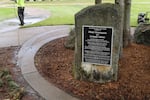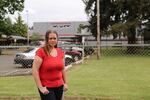On May 21, 1998, a teenage boy wearing a trench coat walked into the Thurston High School cafeteria in Springfield, Oregon, and began shooting at his fellow students.

A memorial stands in memory of those lost and wounded on the day of the shooting at Thurston High School 20 years ago. Days before the 20th anniversary, maintenance crew workers cleaned the memorial.
Conrad Wilson / OPB
The shooter was 15-year-old Kipland Kinkel. He was armed with more than 1,000 rounds of ammunition, along with two pistols when he started firing his father’s Ruger .22 caliber rifle.
Kinkel killed two students at Thurston and wounded 25 others. Later, police found Kinkel’s parents’ dead at home. He had shot them as well.
It was the end of a string of deadly school shootings — from Jonesboro, Arkansas, to Pearl, Mississippi — during the 1997-1998 school year.
The 20th anniversary of Thurston comes just days after another school shooting in Santa Fe, Texas. The Thurston shooting happened 11 months before Columbine, at a time when Americans were starting to grapple with mass school shootings as a part of life.
"The pattern of shooting in schools has not changed greatly over the past 20 years in the U.S.," Daniel Webster, an expert at Johns Hopkins University on firearm policy and the prevention of gun violence, wrote in an email to OPB. "Guns continue to be available to too many troubled youth."
The Day Of The Shooting

Jolene Leu was a junior at Thurston High School in Springfield, Oregon, when the shooting happened. On May 21, 1998, Leu was in the cafeteria. Most of the people around her were shot. Today, her daughter goes to Thurston High.
Conrad Wilson / OPB
Jolene Leu was in the cafeteria that morning with friends when Kinkel started shooting.
“It was right before the bell to go to class,” Leu, a junior at the time, recalled during an interview at a park just across the street from the high school. “Pretty much the entire table around me was shot.”
Leu said she remembers feeling frantic. She was sitting next to her boyfriend at the time.
“He had gotten shot in the side, and it had come out his stomach,” she said. “If I had been just a couple of inches closer it could’ve been my back and stomach, or worse. He shared a bullet with another friend. His bullet went through him and then got her in the leg under the table.”
Both friends survived.
Even now, Leu feels a sense of panic and guilt when she talks about that morning 20 years ago.
"I don’t consider myself a survivor,” she said. “I usually reserve that term for the ones that were actually shot. It’s kind of hard for me to associate myself as a survivor because I don’t have the physical scars that everybody else does. So I’m a witness to the tragedy.”
Leu still lives in Springfield.
Standing outside Thurston High, she pointed to where rows of television news trucks lined the street 20 years ago. Flowers and signs of support filled the fence that borders the school grounds. She said that despite the shooting, she loved her high school years.
Last fall, her daughter enrolled as a freshman at Thurston.
“It was hard because they do all of the registration and team sign-ups and everything in the cafeteria. And it hadn’t changed much,” she said. “So having to go in there to sign her up for a class was tough and unnerving. I was watching every door.”
As difficult as it may seem to believe — especially now when yet another school shooting has just happened — school shootings with multiple victims trended down after the 1990s.
Data shows school shootings are relatively rare events; what's changed is the way the media and social media cover and discuss them, said Stephen Brock, a professor of school psychology at California State University, Sacramento.
"School shootings occur very infrequently," Brock said. "Media has changed dramatically since the '80's and 90's ... Facebook, Twitter, Instagram, all of these combined with the 24/7 news cycle quite literately bombard us with images and stories, oftentimes each one more dramatic than the other because they're competing for our attention."
He said it warps perceptions and alters reality.
Larry Bentz, the Thurston High principal at the time of Kinkel's attack, was headed to a meeting at the district office when the shooting happened. He immediately drove to school.
“(I) slowly recognized the magnitude of the disaster because I started counting the ambulances passing me heading into town,” Bentz said.
A New Fear
At the time, the idea of a troubled young man bringing guns from home and firing them at school was something people were starting to voice worries about. Even so, to Bentz, Kinkel wasn’t that guy.
“He was relatively popular,” Bentz said. “His parents were popular people. But what we all did not know was that they all had a very dark family secret around his mental illness and the impact that it had had on their lives.”
Kinkel was diagnosed with paranoid schizophrenia. He later pleaded guilty to the shootings and was sentenced to nearly 112 years in prison, where he remains today.
Related: Kip Kinkel Loses Bid For Shorter Sentence
“He’s a smart guy, he’s got a high IQ,” said Dennis Balske, one of Kinkel’s attorneys. “But when he wasn't medicated, which he wasn't back then, his thinking was anything but normal. By definition, his illness caused him to think in a way that led him only in one direction.”
Kinkel is working to get a new trial that could allow him to leave his Oregon prison cell and go to the state’s mental hospital.
“Everybody, I think, thinks he is some kind of a monster, when in fact he was a severely mentally ill youngster,” Balske said.
Despite his having killed her parents too, Kinkel and his sister remain close.
“Kip’s in prison and her parents are dead and yet she’s behind him all the way,” Balske said. “You won’t find a brother and sister any closer than them.”
Balske said Kinkel's sister used her parents’ life insurance money to pay for his legal appeals.
Echoes Of A Dark Day
Less than a year after the shooting at Thurston High, 12 students and one teacher were killed at Columbine High School in Littleton, Colorado.
“Columbine eclipsed all of the previous school shootings because of the magnitude of the evil, the number of casualties, the type and scope of weapons that those two boys were able to put together,” Bentz said.
Bentz has the dubious distinction of having led two schools through shootings and their aftermaths. In 2007 he was principal of an alternative high school in suburban Portland when the building was shot up by a student. No one was killed but a few were injured by broken glass.
“It wasn’t until later that evening that the adrenaline sagged, and then you’re thinking, ‘Oh my God, twice in a career,’” he said.
“I can’t tell you how to prevent a school shooting. I can help you learn how to respond to it in order to minimize the pain, and that’s what I’ve tried to do over the ensuing years."
Twenty years later, he said he’ll remember the shooting at Thurston the same way he does every year.
“By myself,” Bentz said. “I sit and I think and remember the smell of the blood in the cafeteria at midnight. And then I turn around and remember those kids who came back to that school the next week and who fought their way towards as normal of life as they could hope to have.”
